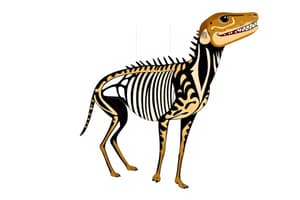Podcast
Questions and Answers
What are the five key characteristics that chordates possess?
What are the five key characteristics that chordates possess?
Notochord, hollow dorsal nerve cord, pharyngeal slits, endostyle, and post-anal tail.
What is the difference in the presence of notochord in the three subphyla of Chordata?
What is the difference in the presence of notochord in the three subphyla of Chordata?
In Urochordata, notochord is present only in larval tail; in Cephalochordata, notochord extends from head to tail region and is present throughout life; in Vertebrata, notochord is present during the embryonic period but is replaced by a vertebral column in adults.
List the seven classes within the subphylum Vertebrata?
List the seven classes within the subphylum Vertebrata?
The classes within the subphylum Vertebrata are Agnatha, Chondrichthyes, Osteichthyes, Amphibia, Reptilia, Aves, and Mammalia.
How many subphyla are found within the phylum Chordata and what are they?
How many subphyla are found within the phylum Chordata and what are they?
Do all vertebrates belong to the subphylum Vertebrata?
Do all vertebrates belong to the subphylum Vertebrata?
Flashcards
Chordate Key Characteristics?
Chordate Key Characteristics?
Notochord, hollow dorsal nerve cord, pharyngeal slits, endostyle, and post-anal tail.
Notochord presence in Chordata subphyla?
Notochord presence in Chordata subphyla?
Urochordata: Notochord in larval tail only. Cephalochordata: Notochord head to tail, life-long. Vertebrata: Notochord in embryo, replaced by vertebral column in adults.
Vertebrata Classes?
Vertebrata Classes?
Agnatha, Chondrichthyes, Osteichthyes, Amphibia, Reptilia, Aves, and Mammalia.
Chordata Subphyla?
Chordata Subphyla?
Signup and view all the flashcards
Vertebrates in subphylum Vertebrata?
Vertebrates in subphylum Vertebrata?
Signup and view all the flashcards
Study Notes
Key Characteristics of Chordates
- Chordates possess a notochord, a flexible rod-like structure providing support.
- They have a dorsal nerve cord, which develops into the spinal cord in vertebrates.
- Pharyngeal slits are present at some stage, aiding in filter feeding or respiration.
- A post-anal tail extends beyond the anus, which may not be present in all adult forms.
- They exhibit a segmented body plan with repeated elements in muscles and skeletal structures.
Notochord Presence in Subphyla of Chordata
- In Urochordata (tunicates), the notochord is present only during the larval stage and is lost in adults.
- Cephalochordata (lancelets) maintains a notochord throughout life, serving as a main support structure.
- In Vertebrata, the notochord is replaced by the vertebral column as development progresses.
Classes within Subphylum Vertebrata
- Agnatha: Jawless fish, such as lampreys and hagfish.
- Chondrichthyes: Cartilaginous fish, including sharks and rays.
- Osteichthyes: Bony fish, characterized by a bony skeleton.
- Amphibia: Amphibians, including frogs, toads, and salamanders.
- Reptilia: Reptiles, such as snakes, lizards, turtles, and crocodilians.
- Aves: Birds, known for feathers, beaks, and laying hard-shell eggs.
- Mammalia: Mammals, distinguished by fur or hair and mammary glands.
Subphyla within Phylum Chordata
- Three subphyla are found within the phylum Chordata:
- Urochordata: Tunicates as the most primitive group.
- Cephalochordata: Lancelets that retain chordate features into adulthood.
- Vertebrata: Organisms with a vertebral column, including all vertebrates.
Vertebrates and Subphylum Classification
- All vertebrates belong to the subphylum Vertebrata, which includes diverse organisms with backbone structures.
Studying That Suits You
Use AI to generate personalized quizzes and flashcards to suit your learning preferences.




